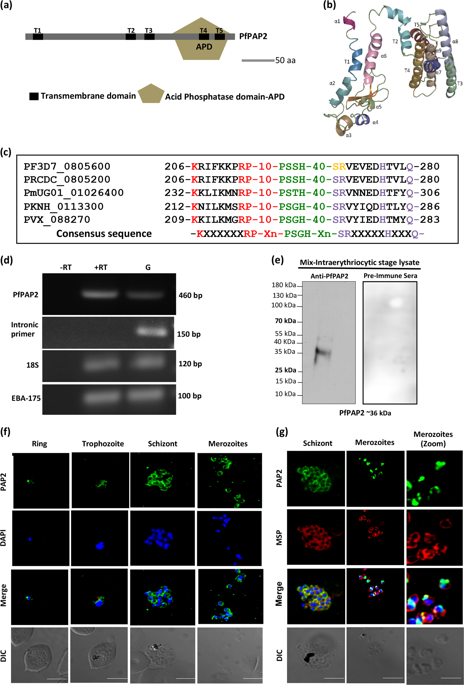Cell Death Discovery ( IF 6.1 ) Pub Date : 2019-06-24 , DOI: 10.1038/s41420-019-0187-1 Raj Kumar Sah , Swati Garg , Poonam Dangi , Kalaiarasan Ponnusamy , Shailja Singh

|
Type-2 phosphatidic acid phosphatase (PAP2) a member of PAP2 superfamily mediates the conversion of phosphatidic acid (PA) to diacylglycerol (DAG) and thus plays a pivotal role in numerous cellular signaling processes in diverse organisms. An elevated level of intracellular PA is detrimental for the cell and induces cell death. In this study we identified and characterized a PAP2 homologue in Plasmodium falciparum, PfPAP2 and further elucidated its significance in regulation of PA homeostasis in parasite life cycle. PfPAP2 is expressed in the blood stage and harbors the canonical acid phosphatase domain (APD) with signature motifs. PfPAP2 catalyzes the dephosphorylation of PA to produce DAG and inorganic phosphate (Pi). Propranolol, a generic inhibitor of PAP2, inhibited the phosphatase activity of PfPAP2 by binding to the active site of APD domain as evident by in silico docking and confirmed by surface plasmon resonance (SPR) analysis. Inhibition of native PfPAP2 by propranolol led to rise in intracellular PA mediating disruption of intracellular PA homeostasis in parasites. The propranolol mediated inhibition of PfPAP2 directed early secretion of a micronemal Perforin like Protein, PfPLP1 leading to untimely permeabilization and host cell egress. The merozoites following premature egress were non-invasive and were attenuated to invade erythrocytes and cannot continue next cycle growth. This study demonstrates that disruption of PA homeostasis can cause growth retardation in malaria parasites, and thus its master regulator, PfPAP2, can serve as a very good molecular target for antimalarial chemotherapeutic interventions.
中文翻译:

由2型磷脂酸磷酸酶调节的磷脂酸稳态代表了疟疾干预中的新型药物靶点
作为PAP2超家族成员的Type-2磷脂酸磷酸酶(PAP2)介导了磷脂酸(PA)向二酰基甘油(DAG)的转化,因此在多种生物的许多细胞信号传导过程中起着关键作用。升高的细胞内PA水平对细胞有害并诱导细胞死亡。在这项研究中,我们鉴定和鉴定了恶性疟原虫PfPAP2中的PAP2同源物,并进一步阐明了其在寄生虫生命周期中调节PA稳态的重要性。PfPAP2在血液阶段表达,并带有带有标志性基序的规范酸磷酸酶结构域(APD)。PfPAP2催化PA的去磷酸化以产生DAG和无机磷酸盐(P i)。普萘洛尔,一种PAP2的通用抑制剂,通过与APD结构域的活性位点结合而抑制PfPAP2的磷酸酶活性,这在计算机对接中很明显,并通过表面等离子体激元共振(SPR)分析得到了证实。普萘洛尔对天然PfPAP2的抑制作用导致细胞内PA升高,介导寄生虫中细胞内PA稳态的破坏。普萘洛尔介导的对PfPAP2的抑制作用可导致微量的穿孔素样蛋白PfPLP1的早期分泌,导致过早的通透性和宿主细胞的排出。早泄后的裂殖子是非侵入性的,被削弱后侵入红细胞,不能继续下一周期的生长。这项研究表明,PA动态平衡的破坏会导致疟原虫的生长发育迟缓,因此其主要调控因子PfPAP2,











































 京公网安备 11010802027423号
京公网安备 11010802027423号